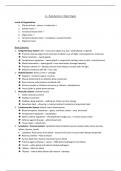L1 – Body Systems + Major Organs
Levels of Organisation:
1. Chemical level – atoms -> molecules ->
2. Cellular level ->
3. Functional tissue level ->
4. Organ level ->
5. Functional System level – completes 1 overall function
6. Organism level
Body Systems:
1. Integumentary System: skin + accessory organs e.g. hair, sweat glands, oil glands
➔ Protects internal organs from external conditions e.g. UV light, microorganisms, chemicals
➔ Water retention – sweat glands
➔ Temperature regulation – sweat glands = evaporative cooling, hairs on skin = erect/unerect,
➔ Waste elimination – sweat glands = lose electrolytes through sweating
➔ Produces vitamin D – absorbs calcium from being in contact with UV light
➔ Detects sensations with NS – hot, cold
2. Skeletal System: bones, joints + cartilage
➔ Supports + protects organs + tissues
➔ Muscle attachments to skeleton allow movement
➔ Bone marrow cells produce red blood cells
➔ Stores minerals in red bone marrow e.g. calcium + phosphorous
➔ Stores lipids in yellow bone marrow
3. Muscular System: skeletal muscle
• Under voluntary control
➔ Enables movement
➔ Stabilises body position – walking on 2 feet uses less energy
➔ Generates heat – shivering = muscles contract involuntary to generate heat
4. Cardiovascular System: blood, heart, blood vessels
➔ Blood transports substances – gases, nutrients, waste – urea, hormones
➔ Temperature regulation - vasodilation
➔ Water content regulation – drinking fluid changes pcy -> remove excess water
➔ Defence against disease – white blood cells
➔ Tissue repair – blood clots
5. Lymphatic + Immune System: lymphatic fluid, lymphatic vessels, lymph nodes, bone marrow,
spleen, thymus, tonsils
• Lymphatic fluid comes from blood – excess fluid stuck in tissue when being transported
➔ Returns proteins + fluid to blood
➔ Carries lipids from Gastro Intestinal tract to blood
➔ Protects against disease + cancer – WBC detect pathogens from blood
➔ Tonsils – white blood cells detect inhaled pathogens
➔ Spleen – filter for blood
➔ Thymus – where white blood cells mature + develop
,6. Endocrine System: hormone-producing glands e.g. hypothalamus - ADH, pituitary, thymus =
thymosin, thyroid gland = thyroxine, adrenal gland = aldosterone, pancreas, ovaries, testes…
➔ Releases hormones from glands to have specific effects on target organs
➔ Maintain homeostasis
➔ Co-ordinate range of body functions
7. Nervous System: brain, spinal cord, nerves, special sense organs = eyes, ears
➔ Generate nerve impulses to regulate body activities
➔ Detects stimuli + responds
➔ Stimuli = baroreceptors, chemoreceptors, thermoreceptors, osmoreceptors -> homeostasis
➔ Responses = Initiates muscle contraction, gland secretion
8. Respiratory System: lungs, air passages, pharynx = throat, larynx = voice box, trachea = connects
lungs + larynx, bronchioles, alveoli
➔ Gaseous exchange
➔ Regulates acid-base balance within body – regulates CO2 levels –
CO2 + H20 <-> H+ + HCO3- <- Bicarbonate ion = buffer
➔ Enables sound production when air passes through vocal cords inside larynx
9. Digestive System:
• Organs of GI tract = mouth, pharynx, oesophagus, stomach, small + large intestines +
• Accessory organs = salivary glands, gall bladder, liver, pancreas
➔ Physical breakdown of food = chewing + churning of stomach
➔ Chemical breakdown of food = enzymes
➔ Absorbs nutrients from food
➔ Eliminates solid waste from food which can’t be absorbed
10. Urinary System: kidneys -> ureters -> bladder -> urethra
➔ Makes, stores + eliminates urine
➔ Eliminates metabolic waster
➔ Regulates volume + chemical composition of blood
➔ Maintains acid-base balance of body fluids (pH -> enzyme denaturation -> metabolic death)
➔ Regulates production of RBC = kidneys secrete erythropoietin protein -> increases RBC
production
11. Reproduction System: ovaries, uterus, fallopian tubes, vagina + testes, epididymis, vas deferens,
penis
➔ Gamete production
➔ Hormone release
Regulates reproduction + associated body changes during puberty
L2 – Tissue Types + Structures
Tissue: a group of similar cells that usually have common embryonic origins + function together to
perform specialise functions
Embryo Tissues:
Inside endoderm -> epithelial cells
Middle mesoderm -> muscle tissue, epithelial cells, connective tissue
Outside ectoderm -> muscle tissue, epithelial cells
, Cell Junctions: connect cells in tissues together
Cell Junctions:
a) Tight Junction:
• Forms impermeable seals between adjacent cells
• Run continuously around cell circumference
• Impermeable barrier – water, pathogens, virus – cant
enter
• Mostly in epithelial cells e.g. skin
• Made of transmembrane protein
b) Adherens Junction:
• Mechanical role = hold cells together to resist strains + stresses -> cells
don’t get pulled open
• Adhesion belt: cadherin = transmembrane protein connects internally to
actin = microfilament
• Spread stresses through whole cell
• Part of cytoskeleton
• Doesn’t prevent substance exchange
c) Desmosome Junction:
• Holds cell together
• Confined to small regions around adjacent cells
• Cadherin joins adjacent cells together in intracellular space
• Keratin = intermediate filament -> connects to desmosome junctions
➔ Stresses spread throughout whole tissue
d) Hemidesmosome:
• Resists cells being pulled off basement membrane
• Integrin = transmembrane protein – connects plaque to basement
membrane
• Keratin = intermediate filament
e) Gap Junction:
• Forms pore between adjacent cells
• Allows cell-cell communication
• Allows movement of ions + small molecules e.g. ATP
• Each cell has 6 connexons = join in intercellular space
• Cells electrically coupled together
➔ Electrical signal delivered to cardiac muscle
gets passed onto adjacent cells allowing heart to contract
Tissue Types:
1. Nervous Tissue:
• Detects internal + external changes in environment + acts to
maintain homeostasis
• Responsible for detection of signals, cognition + self-awareness
Cell Types:
a. Neurons: generate + conduct nerve impulses




